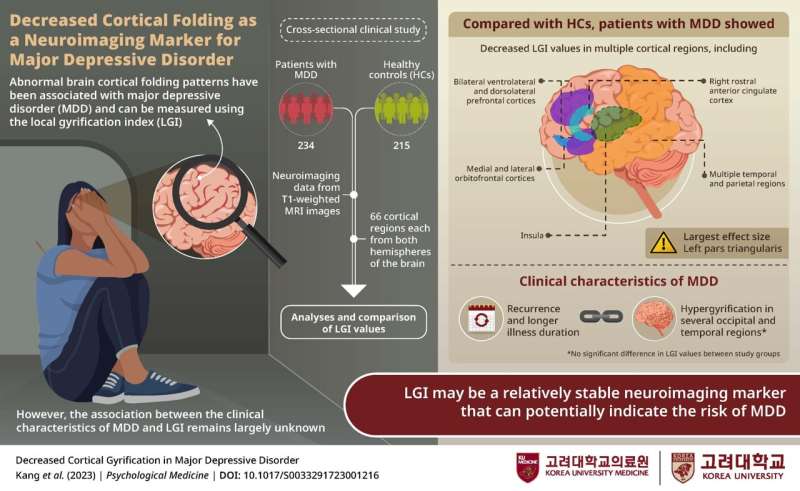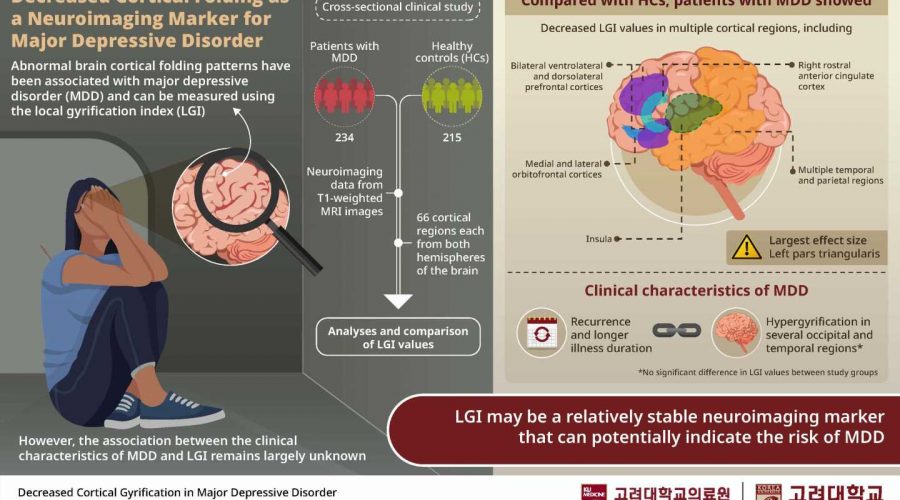Study highlights a new biomarker for major depressive disorder

Major depressive disorder (MDD) is a complex and debilitating metal illness. Given its complex and widespread nature, MDD has been a subject of intense medical research. Previous studies have found associations between MDD and abnormal cortical folding in the brain, but a reliable physiological indicator has remained elusive.
Now, a study published in Psychological Medicine by researchers from Korea reports the successful identification of a neuroimaging-based biomarker that could revolutionize MDD diagnosis.
In appearance, the human brain’s outermost layer, called the cortex, is a maze of tissue folds. The peaks or raised surfaces of these folds, called gyri, play an important role in the proper functioning of the brain. Improper gyrification—or the development of gyri—has been implicated in various neurological disorders, one of them being the debilitating and widespread mental illness, major depressive disorder (MDD).
Although prior studies have shown that abnormal cortical folding patterns are associated with MDD, a reliable indicator has so far remained out of reach.
Now, in a positive turn of events, researchers led by Professor Byung-Joo Ham and Associate Professor Kyu-Man Han from Korea University Medicine have reported the successful identification of a neuroimaging-based biomarker for MDD.
Talking about the unique finding that sets apart their study from the previous ones, Prof. Ham explains, “Our first-of-its-kind study investigated the association of MDD with the local gyrification index or LGI of multiple cortical regions at the whole-brain level and the association of LGI with the clinical characteristics of MDD.”
But what is local gyrification index (LGI)?
LGI is a measurement of cortical folding that is derived from brain scans as a ratio of the curved and smoothed surfaces of the cortex in a region of interest. In this study, the researchers compared the LGI values from multiple cortical regions in the brain of patients with MDD with those of healthy individuals. The neuroimaging data used to compare and analyze both groups were obtained from magnetic resonance imaging scans.
Prof. Ham and his team showed that LGI values from multiple cortical regions in the brain of patients with MDD showed hypogyrification—a condition characterized by decreased cortical folding—when compared with healthy individuals.
They found that patients with MDD showed significantly lower LGI values in seven out of the 66 cortical regions assessed (in both hemispheres of the brain), which included the prefrontal cortex, anterior cingulate cortex, insula, and several temporal and parietal regions. Notably, the most significant hypogyrification was observed in the left pars triangularis of patients with MDD.
When asked to share his thoughts about the study’s results, Dr. Han asserts that there is more to their findings than meets the eye. “The cortical regions that we assessed in our study have been previously shown to affect emotional regulation. This means that abnormal cortical folding patterns may be associated with the dysfunction of neural circuits involved in emotional regulation, thus contributing to the pathophysiology of MDD,” he said.
The study’s findings firmly establish LGI as a relatively stable neuroimaging marker for MDD, when compared with previously identified biomarkers. This is because LGI values reflect the long-drawn developmental process of gyrification that is not spontaneously affected by an individuals’ state during the measurement process.
It is also worth highlighting the robustness of this study, given that it involved a larger sample size of participants, which gives it an edge over similar studies conducted previously.
Interestingly, the researchers noted that the clinical characteristics of MDD, including the recurrence and duration of illness in patients, were associated with increased gyrification in several occipital and temporal cortical regions. However, they did not observe any significant difference in the LGI values in these regions between the patient and control groups.
With the head start given by this study, future research could explore the genetic factors that predispose individuals to abnormal cortical folding patterns, and, in turn, MDD. The study can also serve as a roadmap for the selection of cortical regions as targets for medical treatments aimed at reducing the symptoms of this condition.
Overall, by identifying a new biomarker for MDD, this study has paved the way for a deeper understanding of a serious and pervasive mental health problem, which could hopefully take the medical community one step closer to finding an effective solution in the future.
More information:
Youbin Kang et al, Decreased cortical gyrification in major depressive disorder, Psychological Medicine (2023). DOI: 10.1017/S0033291723001216
Journal information:
Psychological Medicine
Source: Read Full Article
